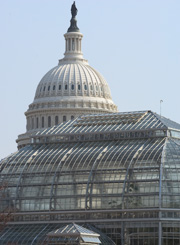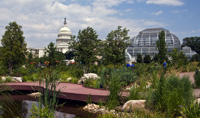|
|

|
|
|
|
|
George Washington, Thomas Jefferson and James Madison shared the dream of a national botanic garden and were instrumental in establishing one on the National Mall in 1820.
The was formally placed under the jurisdiction of the Joint Committee on the Library of Congress in 1856 and has been administered through the Office of the Architect of the Capitol since 1934. The Architect of the Capitol has served as Acting Director of the United States Botanic Garden and is responsible for the maintenance and operation of the Garden and for any construction, changes, or improvements made.
For information on exhibits and visiting the U.S. Botanic Garden, visit usbg.gov.
|
|
|
|

The original conservatory housing the U.S. Botanic Garden, in front of the still under construction U.S. Capitol
|
The institution traces its beginning to 1816, when the constitution of the Columbian Institute for the Promotion of Arts and Sciences in Washington, D.C., proposed the creation of a botanic garden to collect, grow, and distribute plants of this and other countries that might contribute to the welfare of the American people. The Institute's garden was established by Congress in 1820 to the west of the Capitol Grounds, from First Street to Third Street between Pennsylvania and Maryland Avenues. This facility functioned until shortly after the organization stopped holding meetings in 1837.
In 1842, the idea of a national botanic garden was reestablished when the United States Exploring Expedition to the South Seas (the Wilkes Expedition) brought to Washington a collection of living plants from around the globe. Initially placed in a specially constructed greenhouse behind the Old Patent Office Building, the plants were moved in late 1850 into a new structure on the site previously occupied by the Columbian Institute's garden.
In continuous operation and open to the public since 1850, the Botanic Garden moved to its present location in 1933, a complex located along the north and south sides of Independence Avenue bordered by First Street and Third Streets, S.W. The Garden includes the ; the , which opened in 2006; and , which was created in 1932.
|
|
|
|

U.S. Botanic Garden
|
The United States Botanic Garden Conservatory is a window to the world. Its exhibits span 150 million years, the range of global environments, as well as botany, economy and culture -- all the ways plants are important to how we live and our planet's survival.
Constructed by the Architect of the Capitol in 1933, this Lord & Burnham greenhouse contains eight garden rooms under glass, totaling 28,944 square feet of growing space. In 2001, the Conservatory re-opened after a four-year that required it to be completely dismantled and rebuilt for the 21st century.
|
|
|
|

The National Garden
|
Opened to the public on October 1, 2006, the National Garden provides "living laboratories" for environmental, horticultural, and botanical education in a contemplative setting. The major features of the National Garden are the Rose Garden, the Butterfly Garden, the Lawn Terrace, the First Ladies' Water Garden, the Regional Garden, and an outdoor amphitheater.
The Rose Garden is designed as an outdoor garden room featuring many varieties of the rose, the national flower. The First Ladies' Water Garden, a simple but elegant square with a frame of surrounding paving, is designed to create a memorable image of the central role that water plays in the well-being of plants, animals, and humankind. The Water Garden honors the First Ladies of the United States by recognizing their notable service to our country. The Regional Garden presents outstanding plants native to the mid-Atlantic region in naturalistic settings arranged along a moisture gradient.
|
|
|

The Botanic Garden Administration Building |
The Bartholdi Park was created in 1932 and named for Frederic Auguste Bartholdi, the sculptor of the historic fountain located at its center. The beds in the park were geometrically arranged and planted in formal classical style to feature the fountain and to accommodate public gatherings. The plantings have been redesigned during the last decade and are continuously updated to reflect modern trends in American horticulture and new plant introductions. The park now serves as a home landscape demonstration garden and showcases innovative plant combinations in a variety of styles and design themes. The U.S. Botanic Garden Administration Building is located in the park.
|
|
|
|
A opened in Anacostia in 1993 includes greenhouse bays and maintenance shops. The production facility is the largest greenhouse complex supporting a public garden in the United States. The greenhouse, completed in 1994, includes 85,000 square feet under glass divided into 34 greenhouse bays and 16 environmental zones.
|
|  |
|
|
| | |